Timing & trends
The ghost of Very Light Jets hovers over Amazon’s drones
Jeff Bezos’s plan to start delivering packages in the US by drone reminds me of a quote from The Everything Store, the Brad Stone book that recently won the FT and Goldman Sachs Business Book of the Year award:
[Bezos] is not tethered by conventional thinking … he is bound only by the laws of physics. He can’t change those. Everything else, he views as open to discussion.”
….read it all HERE
I am excited by what happened.
 China`s Exciting Announcement
China`s Exciting Announcement
Jim Rogers Discusses Currency Wars, Inflation And Gold
In the fifteen minute interview below (on November 28th) Jim Rogers discusses how he is able to make accurate predictions about the financial markets.
Rogers explains that his starting point is to start thinking in a contrarian way when everyone else is thinking the same thing.
He also thinks it is very important to be aware that the current state of affairs are always just a temporary phenomenon. Change is always just around the corner and getting ahead of that change is how to invest successfully.
Congress’s latest attempt at crafting a budget plan is on track to end up the same way as others have in the past decade: with little or no agreement.
Negotiators have little chance of breaking this string of futility, even after a 16-day government shutdown in October that cost the U.S. economy $24 billion. If they do, it’ll only be to curb automatic spending cuts, including $19 billion that hits the Pentagon starting in January.
Now budget experts, labor unions and business groups are saying enough’s enough, and questioning why lawmakers can’t live within their means the way ordinary Americans do and instead lurch from one budget standoff to the next.
“It’s a stupid way to run a country,” said Maya MacGuineas, head of the Campaign to Fix the Debt, a non-partisan advocacy group whose members include business leaders and former lawmakers. “Change comes from two possible things: a crisis or leadership.”
One of the co-chairmen of the campaign is Michael Bloomberg, founder and majority owner of Bloomberg News parent Bloomberg LP and the New York City mayor.
Unlike with previous budget panels, including the failed 2011 supercommittee, there are no immediate consequences if the budget conference misses its Dec. 13 deadline — the U.S. won’t default on its debt and the federal government won’t shut down for lack of funding.
The committee’s lack of progress is frustrating outside groups, especially business executives, who say congressional lawmakers’ habit of governing by crisis and temporary spending bills is hurting the economy and costing jobs.
‘Chilling Effect’
“The uncertainty has a chilling effect on job creators, households and anybody who’s trying to see around a corner,” said MacGuineas, who is also president of the Committee for a Responsible Federal Budget, a fiscal advocacy group.
Congress in 2009 last passed a budget resolution, the equivalent of a household budget that sets spending parameters for the federal government.
In 2010, disagreement over how to handle the scheduled expiration of tax cuts enacted under former President George W. Bush prevented agreement on a budget resolution and Republicans won the House majority, creating a divided Congress.
The current panel is the fifth bipartisan attempt in three years to address the nation’s debt and deficit. The others, starting with the 2010 debt-reduction commission appointed by President Barack Obama, ended in failure.
….continue reading on HERE
This is a review of Technology, Materials, Consumer Discretionary, Industrials, Energy, Financials, Consumer Staples, Health Care & Utilities:
Technology
· Trend remains up (Score: 1.0). Units closed at a 13 year high on Wednesday
· Units remain above their 20 day moving average (Score: 1.0)
· Strength relative to the S&P 500 Index changed from negative to neutral (Score: 0.5)
· Technical score based on above indicators improved to 2.5 from 2.0 out of 3.0
· Short term momentum indicators returned to overbought levels.
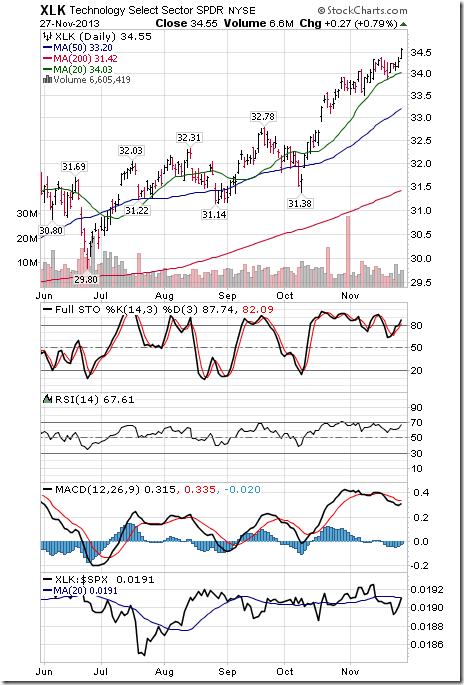
Materials
· Trend remains up. Resistance is forming at $46.07.
· Units remain above their 20 day moving average
· Strength relative to the S&P 500 Index remains negative
· Technical score remains at 2.0 out of 3.0
· Short term momentum indicators are rolling over from overbought levels
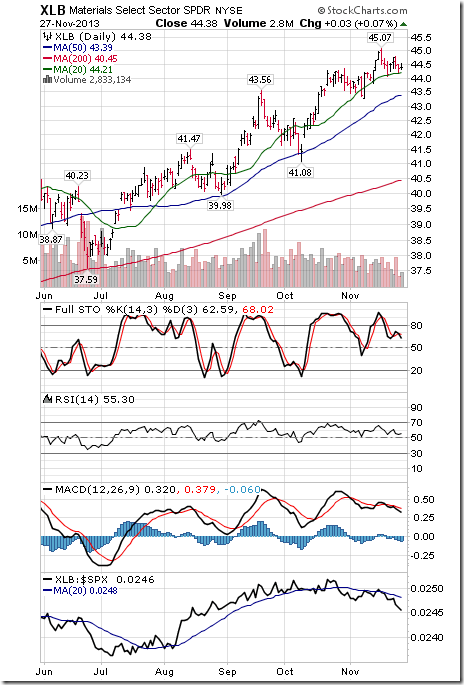
Consumer Discretionary
· Trend remains up. Units closed at an all-time high on Wednesday
· Units remain above their 20 day moving average
· Strength relative to the S&P 500 Index changed from neutral to positive
· Technical score increased to 3.0 from 2.5 out of 3.0.
· Short term momentum indicators returned to an overbought level
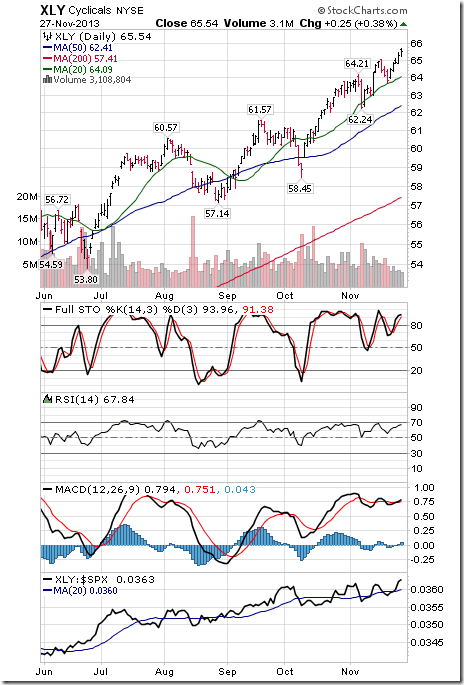
Industrials
· Trend remains up. Units closed at an all-time high on Wednesday.
· Units remain above their 20 day moving average
· Strength relative to the S&P 500 Index improved to positive from neutral
· Technical score increased to 3.0 from 2.5 out of 3.0
· Short term momentum indicators have returned to overbought levels.
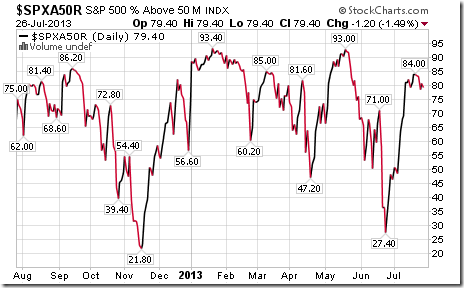
Energy
· Trend remains up.
· Units fell below their 20 day moving average on Wednesday
· Strength relative to the S&P 500 Index remains negative
· Technical score fell to 1.0 from 2.0 out of 3.0
· Short term momentum indicators have rolled over from overbought levels.
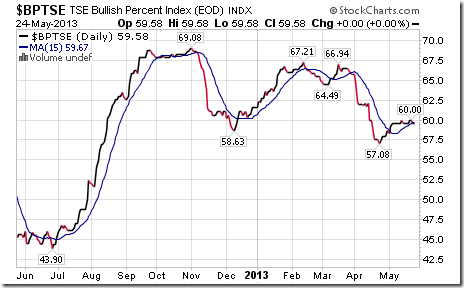
Financials
· Trend remains up.
· Units remain above their 20 day moving average
· Strength relative to the S&P 500 Index remains positive
· Technical score remains at 3.0 out of 3.0
· Short term momentum indicators are overbought.

Consumer Staples
· Trend remains up. Resistance is forming at $43.46
· Units remain above their 20 day moving average
· Strength relative to the S&P 500 Index changed from neutral to negative
· Technical score slipped to 2.0 from 2.5 out of 3.0
· Short term momentum indicators are rolling over from overbought levels.
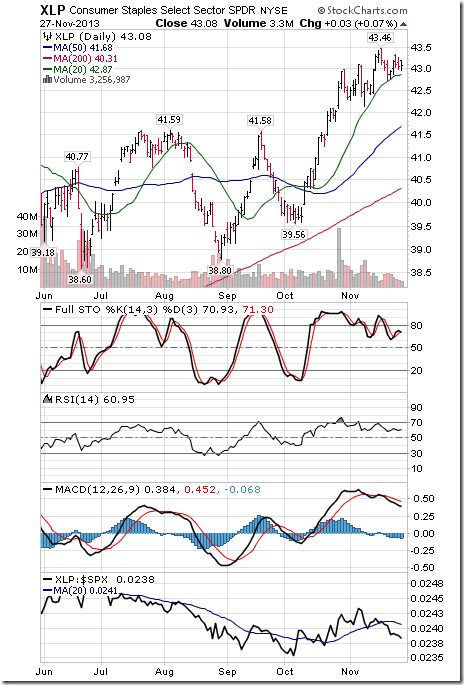
Health Care
· Trend remains up
· Units remain above their 20 day moving average
· Strength relative to the S&P 500 Index remains positive
· Technical score remains at 3.0 out of 3.0
· Short term momentum indicators are overbought.
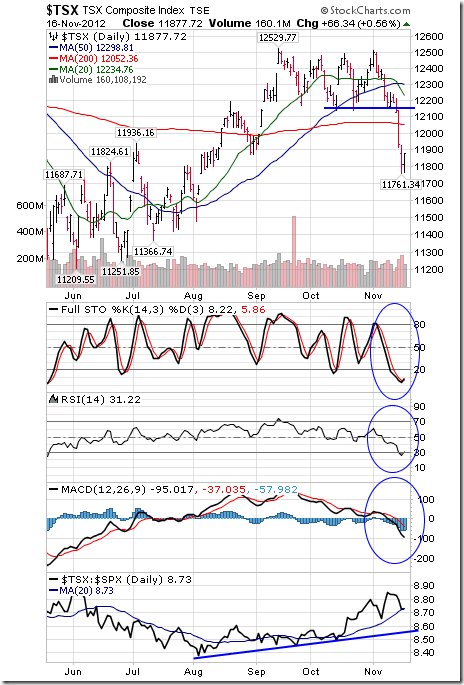
Utilities
· Trend changed from up to down on a move below $38.18
· Units remain below their 20 day moving average
· Strength relative to the S&P 500 Index remains negative.
· Technical score dropped to 0.0 from 1.0 out of 3.0
· Short term momentum indicators are trending down.
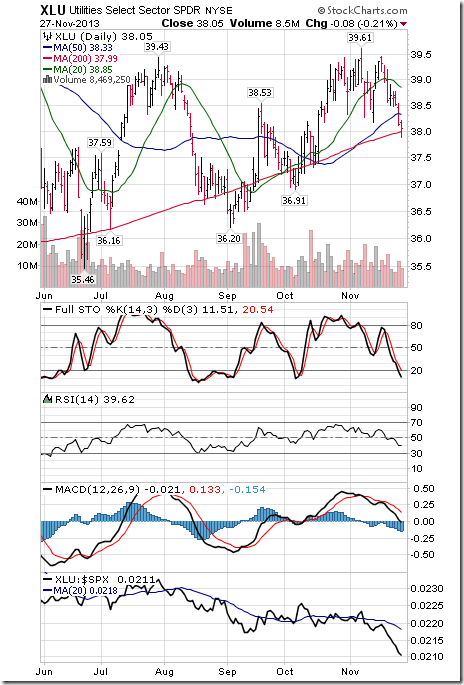
SEASONALITY: Equityclock.com offers free access to seasonal studies on over 1000 big and moderate cap securities and indices, most that have been updated very recently.
To login, simply go to http://www.equityclock.com/charts/
Following is an example:
S&P/TSX Capped Financial Index Seasonal Chart
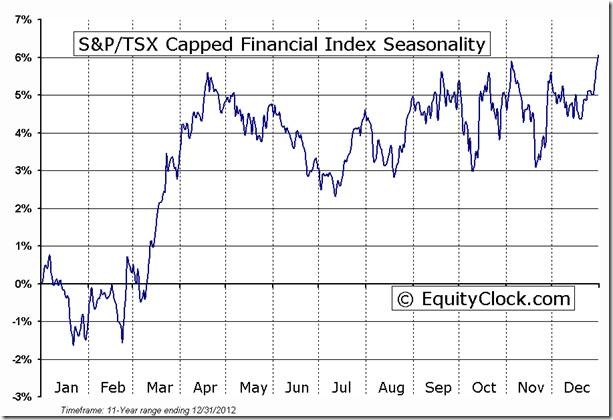
Seven weeks in a row of higher prices, three 1000 marks broken: late-2013 is one for the record books. So it’s the same old story: we (conservative DTL types) don’t own nearly enough stock to fully benefit from this. But on the other hand, at least we’re not short! Are we???
I played the whole “irrational exuberance” hand from the mid-1990s to early 2000s. You know – this market is SO over-priced and can only go down – and bought a bunch of contra, bear funds. Guess how well that worked out? (Hint: I still have to work for a living.)
At some point, the market will crater and the shorts will make tons of dough. But as always, it’s the “when” that matters, and so far guessing the answer to that one has eluded most of us. So ride the bull as the Dow soars towards 20,000 (yes — I read today why that’s not outlandish at all), or sit on the sidelines, but don’t short a rip-roaring bull market unless you just love the thrill of gambling and don’t mind losing.
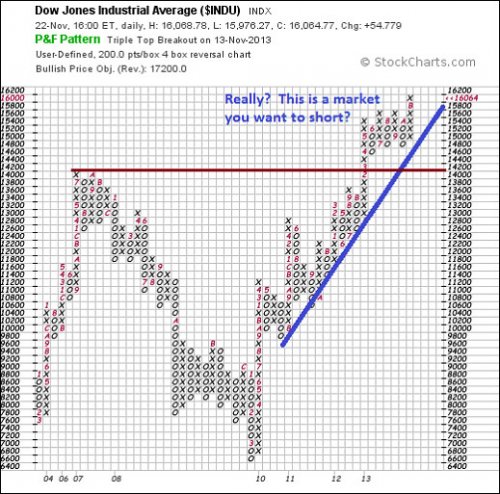
As mentioned last week, it may be that this bull market, or at least this uninterrupted move up in the bull market, will run out of steam sometime in the next month or two. That possibility is based on a number of factors, intuition among them. There’s also the historical tendency for markets to top out at the end of one year/beginning of another. (i.e. gold 1979/80, stocks 1965/1966, stocks 1999/2000). But none of this is to suggest shorting the market. If anything, it may be a time to take profits and diversify some funds into foreign markets, as suggested in previous weeks. Sell on further price gains and wait for a correction to buy those foreign securities (e.g. EFA, EEM, etc), or simply swap US stocks and ETFs for foreign stocks/ETFs straight across the board? Either is a reasonable strategy; choose the one that makes more sense to you.
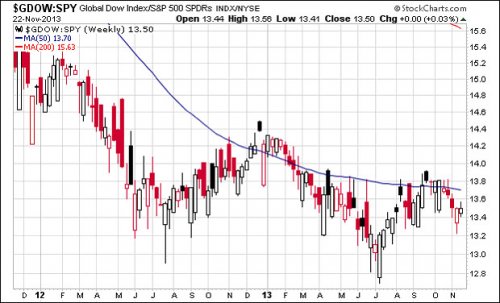
Here the Global Dow Index is shown relative to the S&P 500. It shows that, so far, global stocks have not outperformed US stocks. If one is concerned about the US economy and US dollar however, then this chart implies that there’s still time to own equities while hedging against future US problems. How? By buying foreign stocks/ETFs that are denominated in foreign currencies.
[Hear More: Jeffrey Saut: Portfolio Managers Still in the “Disbelief Phase” of This Bull Market]
Last week was a bad one for gold, along with silver and the mining shares. I’d like to say that this only means their upward potential is now even greater, but that kind of logic only applies in the very long-term. So ten or twenty years from now, the price of gold will be much higher? Probably so — but does that mean that it’s a “buy” or even a “hold” here? At least according to the charts, the first (gold is a buy here) is a tough argument to make. And even the second (hold your gold) is open to debate among reasonable people after last week’s price action.
Last week I showed a dangerous head-and-shoulders top in gold (I accidentally labeled it a triple-top — sorry). That topping formation unfortunately gave way on the downside, generating a pretty strong sell signal in gold. Here you see a different version of that same chart, with the obvious downside target for gold now being the summer’s lows around $1180. As explained here in the past, based on this kind of market action the odds seem greater than 50/50 that gold’s great bull market that started in 2000 is now over. A break below the $1180 area would almost certainly confirm that judgment.

There ARE charts that show gold’s bull market may still be intact, and so we shouldn’t forego all hope of higher prices. But the most reliable charts and the weight of evidence suggeststhat gold has entered a multi-year period of sideways to lower prices. With all the precious metals that DTL readers and writers own, this certainly is not what we wanted to see. But the odds are, that is the reality we now face.
THEREFORE… If you own a boatload of precious metals, you need to consider your options here. Gold cannot get anything going, even during its seasonally-strongest time of the year, and at the same time sends strong technical signals that there may well be many tough months or years ahead for it. Do you hold, hoping it’s all a market fake-out, or only a few months of lower prices ahead, or hold on forever because you’re convinced that’s the best long-term strategy? Or do you lighten up a bit, look for little rallies to sell into, cut back your precious metals exposure, live to fight another day? Each of us has to make those decisions by ourselves. I’ve been urging you to consider how you might respond in this kind of situation, but won’t presume to tell you what’s best for you and your circumstances.
The stock market seems to offer more upside potential, although I am concerned that US stocks may top out — at least temporarily — in the next few weeks. With the market up 22% for the year, throwing caution to the wind and jumping in now doesn’t make sense. But neither does being entirely on the sidelines, given that 1) there’s no other place to make any money and, 2) we may well have that manic 3rd stage ahead of us that sends stock prices sharply higher still. Moderation and diversification, as always, are the answers. Own some US stocks, own some foreign stocks, own a little foreign currency, keep your precious metals (pared down a fair amount?), and have a healthy cash reserve.
The following is an excerpt of Richard Russell’s Dow Theory Letters. To receive their daily updates and research, click here to subscribe.













